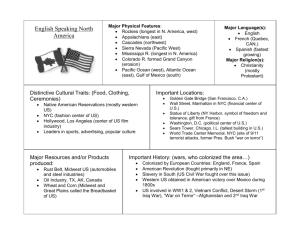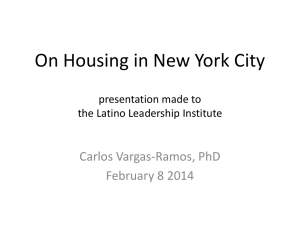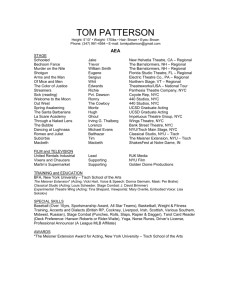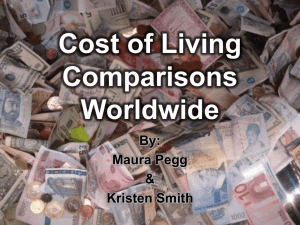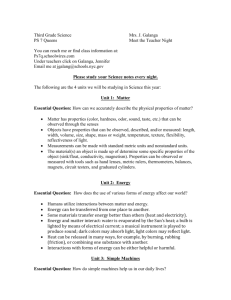URPL-GP.4632.001
advertisement
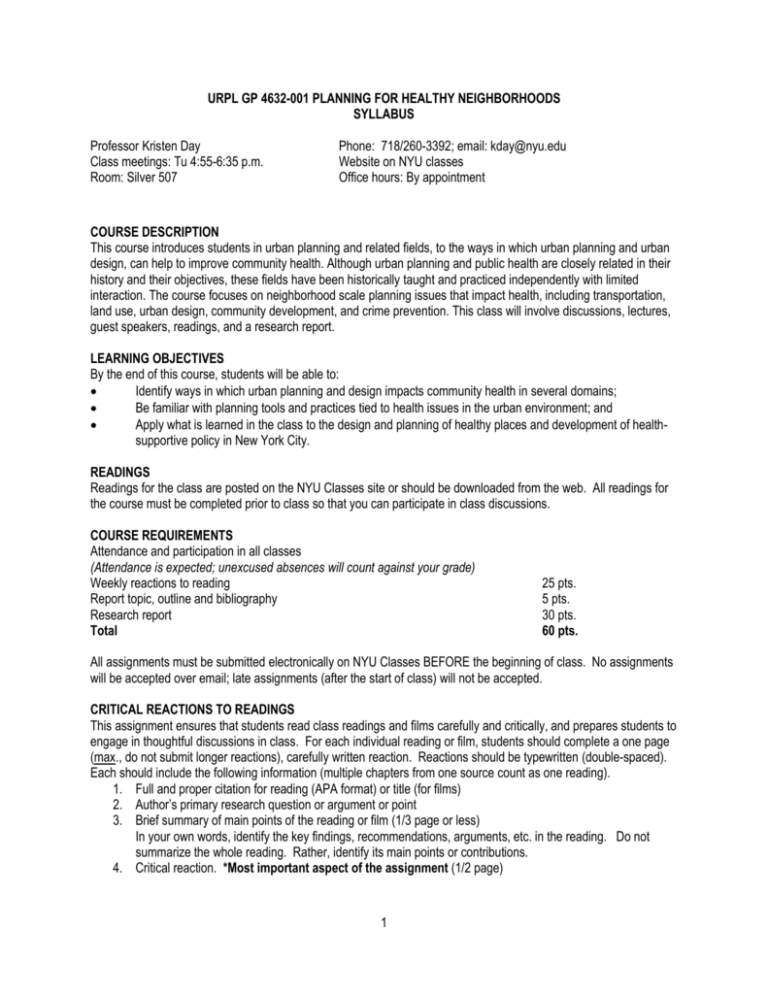
URPL GP 4632-001 PLANNING FOR HEALTHY NEIGHBORHOODS SYLLABUS Professor Kristen Day Class meetings: Tu 4:55-6:35 p.m. Room: Silver 507 Phone: 718/260-3392; email: kday@nyu.edu Website on NYU classes Office hours: By appointment COURSE DESCRIPTION This course introduces students in urban planning and related fields, to the ways in which urban planning and urban design, can help to improve community health. Although urban planning and public health are closely related in their history and their objectives, these fields have been historically taught and practiced independently with limited interaction. The course focuses on neighborhood scale planning issues that impact health, including transportation, land use, urban design, community development, and crime prevention. This class will involve discussions, lectures, guest speakers, readings, and a research report. LEARNING OBJECTIVES By the end of this course, students will be able to: Identify ways in which urban planning and design impacts community health in several domains; Be familiar with planning tools and practices tied to health issues in the urban environment; and Apply what is learned in the class to the design and planning of healthy places and development of healthsupportive policy in New York City. READINGS Readings for the class are posted on the NYU Classes site or should be downloaded from the web. All readings for the course must be completed prior to class so that you can participate in class discussions. COURSE REQUIREMENTS Attendance and participation in all classes (Attendance is expected; unexcused absences will count against your grade) Weekly reactions to reading Report topic, outline and bibliography Research report Total 25 pts. 5 pts. 30 pts. 60 pts. All assignments must be submitted electronically on NYU Classes BEFORE the beginning of class. No assignments will be accepted over email; late assignments (after the start of class) will not be accepted. CRITICAL REACTIONS TO READINGS This assignment ensures that students read class readings and films carefully and critically, and prepares students to engage in thoughtful discussions in class. For each individual reading or film, students should complete a one page (max., do not submit longer reactions), carefully written reaction. Reactions should be typewritten (double-spaced). Each should include the following information (multiple chapters from one source count as one reading). 1. Full and proper citation for reading (APA format) or title (for films) 2. Author’s primary research question or argument or point 3. Brief summary of main points of the reading or film (1/3 page or less) In your own words, identify the key findings, recommendations, arguments, etc. in the reading. Do not summarize the whole reading. Rather, identify its main points or contributions. 4. Critical reaction. *Most important aspect of the assignment (1/2 page) 1 Critical reactions should interrogate the main points of the reading, examining questions such as whether evidence is provided to support the author’s conclusions, new ideas or research questions generated by this reading, interface with other readings of the reading lectures from class, critique of how the author has framed the issues, and especially the implications or film for planning and design. Critical reactions should not do ALL these things—choose the most important and appropriate strategy for reacting to each reading. This should be a thoughtful engagement with each reading or film, not merely a superficial reaction. Reactions to readings/films are due at the beginning of each class. Please bring a copy of your reactions to readings for your own use in class discussions. Reactions are worth 5 points per day. Reactions are graded as √, √– or √+. A grade of √ is equivalent to a B/B+. It indicates that you have read readings and responded thoughtfully. A grade of √+ is equivalent to an A–/A, and acknowledges especially insightful and well-developed responses to readings. A grade of √– is equivalent to a C+/B–. It indicates that you completed the assignment, but showed minimal effort. Reactions are assigned for 6 weeks; only the top 5 reactions will be counted for each student. No late or “make up” reactions are accepted. RESEARCH REPORT: 30 pts. Each student will prepare a professional report on a health and planning issue. The report will examine one urban health issue in the specific context of New York City. The goal of the report is to expand knowledge of how this issue affects New York City and how urban planning perspectives can help to address this issue. Each team will prepare a report to the NYC Department of City Planning. Your report should address one of the following issues: • Urban planning and physical inactivity: Support for walking for travel and recreation • Urban planning and physical inactivity: Support for bicycling for travel and recreation • Urban planning and access to healthy foods: Community gardens and urban farms • Urban planning and access to healthy foods: Public markets and food retail • Urban planning and traffic safety • Urban planning and mental health • Urban planning and violence • Other health issue (please check with instructor in advance) Each report should address: (1) The scope and the nature of this health problem in NYC. What specific forms does this problem take in NYC? How big is this problem in NYC and how is it changing with time? Who is affected by this problem in NYC and how are they affected? What are the major causes of this problem in NYC? (If relevant) How does current urban planning contribute to this problem in NYC? (2) Urban planning solutions to this issue for NYC What are local and regional government agencies doing to address the problem? What are non-profit and other organizations doing to address this problem in NYC? What are the best practices from other U.S. and international cities to address this problem? Specific recommendations for new, urban-planning based solutions to this problem for NYC (based on best practices from elsewhere and your own analysis)? Final report should include: Cover page (no page number) Table of contents Page numbers Subheadings to organize the paper Complete and accurate APA citations in text and reference list Figures and tables (for each, include a figure number on figure and in text and a caption. Cite sources for all figures in APA format.) 2 - Report should be 15 pages in length (double-spaced), plus cover, table of contents, and reference list. Reports should be written in 3rd person and should address a professional planning audience. Reports should be based on empirical research and on analysis of professional reports, communications, etc. Reports will be evaluated based on accuracy and thoroughness (how well are questions above addressed?), writing quality, and support for conclusions (based on reference to credible sources, well documented in references.) REPORT OUTLINE AND BIBLIOGRAPHY: 5 pts. Submit the topic for your research report, an outline (1-2 pages) of the specific issues you will address, and a draft bibliography of the scholarly and professional sources you expect to use (at least 15 references, APA format.) SCHEDULE. This schedule is tentative and subject to change. Date Week 1 T, 10/28 Week 2 T, 11/4 Topic Assignments due Web: Active Design guidelines. At: http://www.nyc.gov/html/ddc/html/design/active_desi gn.shtml Week 2 reading reaction due The relationship between urban planning and public health; the social ecological model; health disparities Physical activity and built environments: Overview Guest speaker: Suzanne Nienaber, Partnerships Director, Center for Active Design Week 3 T, 11/11 Readings Physical activity and built environments: How to implement active design Web: Active Design guidelines: Shaping the sidewalk experience; books 1, 2. At: http://www.nyc.gov/html/ddc/html/design/active_desi gn.shtml NYU Classes: Urban Land Institute (2013). 10 principles for building healthy places. Urban Land Institute. Report outline and bibliography due Week 3 reading reaction due NYU Classes: • Active neighborhood checklist; • Active Neighborhood checklist training presentation (discuss these two in one reaction) Week 4 T, 11/18 Pedestrian traffic safety Web: (2014). Vision Zero action plan. At: http://www.nyc.gov/html/visionzero/pdf/nyc-visionzero-action-plan.pdf NYU Classes: James, P. et al. (2014). A health impact assessment of a proposed bill to decrease speed limits on local roads in Massachusetts (U.S.A.), Int. J. Environ. Res. Public Health, 11(10), 10269-10291. 3 Week 4 reading reaction due Week 5 T, 11/25 Planning for food environments: Urban farms and gardens Guest speaker: Anastasia Cole Plakias, Director of Communications & Sales, Brooklyn Grange Rooftop Farm Week 6 T, 12/2 Planning for food environments: Food retail and public markets Guest speaker: Kelly Verel, Senior Associate, Project for Public Spaces **Meet at Project for Public Spaces, 419 Lafayette Street, Seventh Floor, NY NY (between Astor Place and East 4th Street, just south of the Public Theater) Web: Ackerman, K. (2011). The potential for urban agriculture in New York City. Growing capacity, food security, & green infrastructure. NYC: Urban Design Lab. At: http://www.urbandesignlab.columbia.edu/sitefiles/file /urban_agriculture_nyc.pdf Week 5 reading reaction due Watch the documentary film “The Garden” (2008). Available on NYU Classes if possible or through Amazon Instant Video at: http://www.amazon.com/dp/B002LWHZLM/?tag=go cous20&hvadid=47540374984&hvpos=1o1&hvexid=&hv netw=g&hvrand=14550045610579762893&hvpone= &hvptwo=&hvqmt=b&hvdev=c&ref=pd_sl_8wiv02mr 0x_b (Will be a charge for viewing on Amazon. May require download of software for viewing.) Web: Brannen, S. (2010). Foodworks. A vision to improve NYC’s food system. NYC City Council. At: http://council.nyc.gov/downloads/pdf/foodworks_fullr eport_11_22_10.pdf Week 6 reading reaction due NYU Classes: Cummins et al., (2014). New neighborhood grocery store increased awareness of food access but did not alter dietary habits or obesity, Health Affairs, 33(2), 283-291. Response: Lehmann, Y. et al. (2014). A new grocery store and obesity rates, Health Affairs, 33 5), 906-907. Response: Cummins et al., (2014). Grocery stores and obesity: The authors reply, Health Affairs, 33(5), 907. (discuss these three in one reaction). Web: Project for Public Spaces, “Public Market Services.” At: http://www.pps.org/services/services/ (review this website before class; no written reaction needed) Week 7 T, 12/9 Violence, mental health and social capital Meet at Kris Day’s home Web: Watch the film Cities on Speed: Bogota Change. At: http://www.youtube.com/watch?v=bwgWM3h_l-4 NYU Classes: Svendsen et al. (2010). Sociospatial planning in the creation of bridging social capital: The importance of multifunctional centers for intergroup networks and integration, International 4 Week 7 reading reaction due Research report due on Friday 12/12/14, 5 p.m. Journal of Social Inquiry, 3 (2), 45-73. 5

